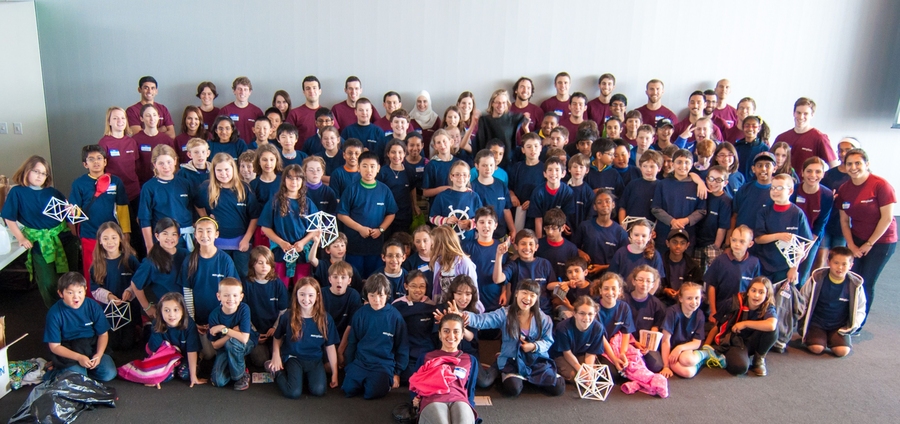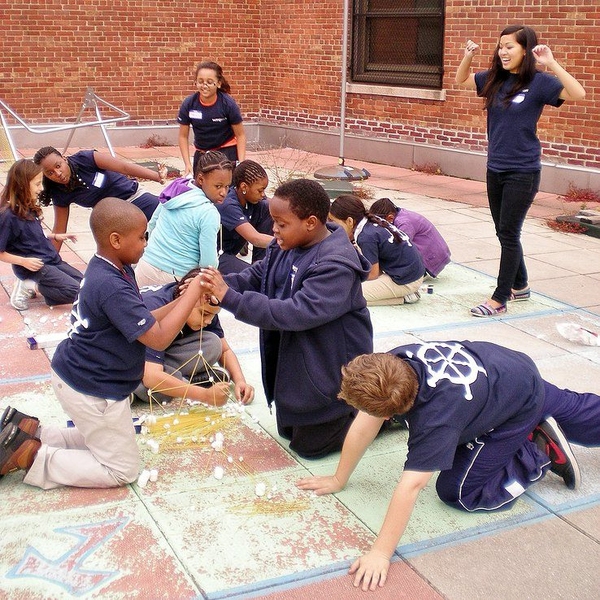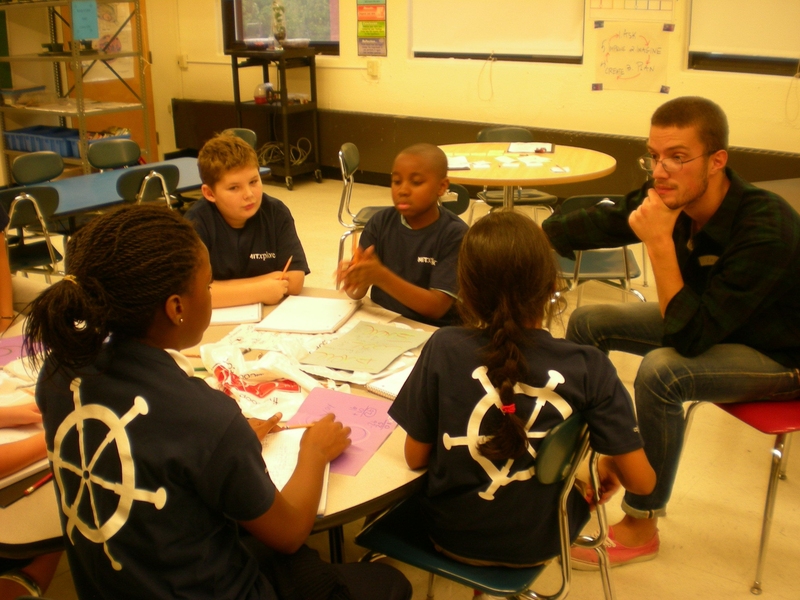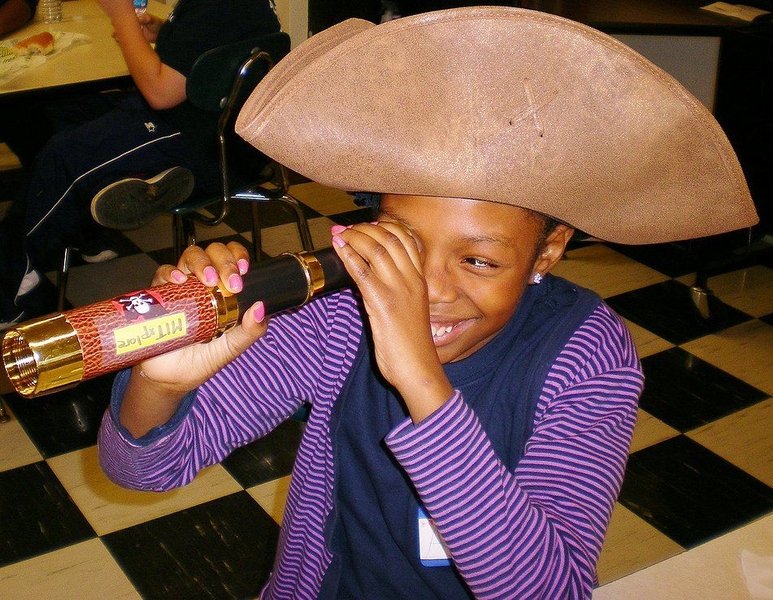“We’re going to explore math.”
That’s the adventure MITxplore co-founders Leon Dimas, Narges Kaynia and Debbie Nguyen say they are trying to bring to the lives of local fifth graders through a weekly after-school program focused on participatory mathematics. Every week, about 10 students at both the Fletcher Maynard Academy in Cambridge and the Hurley School in Boston meet with three MITxplore mentors to discuss mathematical concepts, engage in fun activities and learn from each other.
MITxplore’s founders saw a need for more math-focused after-school enrichment programs, specifically those which convey the beauty and creativity inherent in the art of mathematics. They noticed that such programs are more prevalent for science, where exciting hands-on projects draw students, and they wanted to show that math is captivating as well.
As a result, the founders chose to approach mathematics from a different angle than the “dry box of equations” they say many students are familiar with.
“We wanted to make sure children were aware of how creative mathematics can be,” says Dimas, a graduate student in civil and environmental engineering. “Students think it’s cool to explore, to talk about rockets — we wanted to incorporate that into mathematics.”
In MITxplore lessons, students are not expected to understand concepts right away. Confusion is not an unpleasant failure but an opportunity for adventure and learning.
“MITxplore is a group process,” says Kaynia, a graduate student in mechanical engineering. “We tell the kids in the beginning, ‘We’re all explorers on a ship. How do you steer a ship?’ Everyone works together, and that’s how you get from one island to another. A student who struggles with the concepts in class might still have good, outside-the-box ideas. We encourage everyone to discuss and come to a solution together.”
A typical mathematical adventure
MITxplore sessions feature repeating cycles of discussion, activities and reflection. A typical day might start with the mentors asking the students in a Socratic fashion how they would set up a number line. (“Where would you put number one? Where would you put number 50?”) Together, the students build on this, constructing a number line on a whiteboard by asking each other questions and suggesting examples.
“They see for themselves and understand why it is the way it is: why it’s infinite, why there are negative numbers, why it’s mirrored around zero,” says Kaynia. “We only facilitate their own learning; we do not necessarily teach them new math. We believe students have a born intuition and logic, and we’re connecting that with the tools they learn in school.”
From idea to realization
As graduate students at MIT, Dimas, Kaynia and Nguyen say they are in a great position to take advantage of MIT’s unique support structure for innovation and humanitarianism. They reached out to the Public Service Center, faculty and local businesses for funding and advice.
Dimas says he meets a new person with great insights every day. “MIT is a wonderful place to start something,” he says. “All the resources are there; everyone wants to help you.”
“We’re so lucky to be at MIT, with all the knowledge, the resources, the facilities, the inspiration,” Kaynia says. “At some point you ask, ‘What am I doing to give back to society?’”
Ultimately, the mentors of MITxplore hope to answer that question by creating a model for mathematics outreach that can be adopted by anyone. The team is working to create a framework that distills their philosophy and hard work into a clear guide.
“There are many people out there who have the same desire to work with local students,” Kaynia says. “They don’t necessarily have to be a PhD student at MIT — a lot of the magic happens just by creating that discussion. Once this framework exists, parents could use it for their own neighborhood kids.”
The power of mathematical service
All three co-founders derive satisfaction from their work on a deeply personal level. “It’s so wonderfully rewarding seeing that little spark in a kid’s eye when they understand something,” Dimas says. “It’s like you open the door to an entirely new space.”
Nguyen, a graduate student in mechanical engineering, also sees that spark, but to her it represents something different. Growing up as the daughter of Vietnamese refugees, Nguyen says she never would have been able to achieve her dream of studying engineering without the support of inspiring people who told her that her background and her gender did not have to hold her back.
“I think that spark is when they notice their potential to do anything that they want,” Nguyen says.
To help create that spark, MITxplore welcomed grade 4-6 students and parents from around Massachusetts to the MIT Media Lab on May 12 for its Spring Math Treasure Hunt. The day featured talks by Larry Guth, professor of mathematics, and Rodolfo Rosales, professor of applied mathematics, and more than 30 MIT students were on hand to guide the participants through educational activities about probability, geometry and topology, and numbers and limits. MITxplore aims to host a series of similar Math Days in the future.
That’s the adventure MITxplore co-founders Leon Dimas, Narges Kaynia and Debbie Nguyen say they are trying to bring to the lives of local fifth graders through a weekly after-school program focused on participatory mathematics. Every week, about 10 students at both the Fletcher Maynard Academy in Cambridge and the Hurley School in Boston meet with three MITxplore mentors to discuss mathematical concepts, engage in fun activities and learn from each other.
MITxplore’s founders saw a need for more math-focused after-school enrichment programs, specifically those which convey the beauty and creativity inherent in the art of mathematics. They noticed that such programs are more prevalent for science, where exciting hands-on projects draw students, and they wanted to show that math is captivating as well.
As a result, the founders chose to approach mathematics from a different angle than the “dry box of equations” they say many students are familiar with.
“We wanted to make sure children were aware of how creative mathematics can be,” says Dimas, a graduate student in civil and environmental engineering. “Students think it’s cool to explore, to talk about rockets — we wanted to incorporate that into mathematics.”
In MITxplore lessons, students are not expected to understand concepts right away. Confusion is not an unpleasant failure but an opportunity for adventure and learning.
“MITxplore is a group process,” says Kaynia, a graduate student in mechanical engineering. “We tell the kids in the beginning, ‘We’re all explorers on a ship. How do you steer a ship?’ Everyone works together, and that’s how you get from one island to another. A student who struggles with the concepts in class might still have good, outside-the-box ideas. We encourage everyone to discuss and come to a solution together.”
A typical mathematical adventure
MITxplore sessions feature repeating cycles of discussion, activities and reflection. A typical day might start with the mentors asking the students in a Socratic fashion how they would set up a number line. (“Where would you put number one? Where would you put number 50?”) Together, the students build on this, constructing a number line on a whiteboard by asking each other questions and suggesting examples.
“They see for themselves and understand why it is the way it is: why it’s infinite, why there are negative numbers, why it’s mirrored around zero,” says Kaynia. “We only facilitate their own learning; we do not necessarily teach them new math. We believe students have a born intuition and logic, and we’re connecting that with the tools they learn in school.”
From idea to realization
As graduate students at MIT, Dimas, Kaynia and Nguyen say they are in a great position to take advantage of MIT’s unique support structure for innovation and humanitarianism. They reached out to the Public Service Center, faculty and local businesses for funding and advice.
Dimas says he meets a new person with great insights every day. “MIT is a wonderful place to start something,” he says. “All the resources are there; everyone wants to help you.”
“We’re so lucky to be at MIT, with all the knowledge, the resources, the facilities, the inspiration,” Kaynia says. “At some point you ask, ‘What am I doing to give back to society?’”
Ultimately, the mentors of MITxplore hope to answer that question by creating a model for mathematics outreach that can be adopted by anyone. The team is working to create a framework that distills their philosophy and hard work into a clear guide.
“There are many people out there who have the same desire to work with local students,” Kaynia says. “They don’t necessarily have to be a PhD student at MIT — a lot of the magic happens just by creating that discussion. Once this framework exists, parents could use it for their own neighborhood kids.”
The power of mathematical service
All three co-founders derive satisfaction from their work on a deeply personal level. “It’s so wonderfully rewarding seeing that little spark in a kid’s eye when they understand something,” Dimas says. “It’s like you open the door to an entirely new space.”
Nguyen, a graduate student in mechanical engineering, also sees that spark, but to her it represents something different. Growing up as the daughter of Vietnamese refugees, Nguyen says she never would have been able to achieve her dream of studying engineering without the support of inspiring people who told her that her background and her gender did not have to hold her back.
“I think that spark is when they notice their potential to do anything that they want,” Nguyen says.
To help create that spark, MITxplore welcomed grade 4-6 students and parents from around Massachusetts to the MIT Media Lab on May 12 for its Spring Math Treasure Hunt. The day featured talks by Larry Guth, professor of mathematics, and Rodolfo Rosales, professor of applied mathematics, and more than 30 MIT students were on hand to guide the participants through educational activities about probability, geometry and topology, and numbers and limits. MITxplore aims to host a series of similar Math Days in the future.









